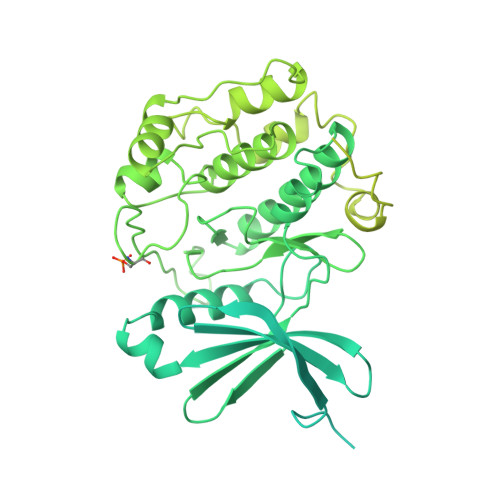The Pif-Pocket as a Target for C. Albicans Pkh Selective Inhibitors.
Pastor-Flores, D., Schulze, J.O., Bahi, A., Giacometti, R., Ferrer-Dalmau, J., Passeron, S., Engel, M., Suess, E., Casamayor, A., Biondi, R.M.(2013) ACS Chem Biol 8: 2283
- PubMed: 23911092
- DOI: https://doi.org/10.1021/cb400452z
- Primary Citation of Related Structures:
4C0T - PubMed Abstract:
The phosphoinositide-dependent protein kinase 1, PDK1, is a master kinase that phosphorylates the activation loop of up to 23 AGC kinases. S. cerevisiae has three PDK1 orthologues, Pkh1-3, which also phosphorylate AGC kinases (e.g., Ypk, Tpk, Pkc1, and Sch9). Pkh1 and 2 are redundant proteins involved in multiple essential cellular functions, including endocytosis and cell wall integrity. Based on similarities with the budding yeast, the Pkh of fungal infectious species was postulated as a novel target for antifungals. Here, we found that depletion of Pkh eventually induces oxidative stress and DNA double-strand breaks, leading to programmed cell death. This finding supports Pkh as an antifungal target since pharmacological inhibition of Pkh would lead to the death of yeast cells, the ultimate goal of antifungals. It was therefore of interest to further investigate the possibility to develop Pkh inhibitors with selectivity for Candida Pkh that would not inhibit the human ortholog. Here, we describe C. albicans Pkh2 biochemically, structurally and by using chemical probes in comparison to human PDK1. We found that a regulatory site on the C. albicans Pkh2 catalytic domain, the PIF-pocket, diverges from human PDK1. Indeed, we identified and characterized PS77, a new small allosteric inhibitor directed to the PIF-pocket, which has increased selectivity for C. albicans Pkh2. Together, our results describe novel features of the biology of Pkh and chemical biology approaches that support the validation of Pkh as a drug target for selective antifungals.
Organizational Affiliation:
Research Group PhosphoSites, Medizinische Klinik 1, Universitätsklinikum Frankfurt, Theodor-Stern-Kai 7, 60590 Frankfurt, Germany.















